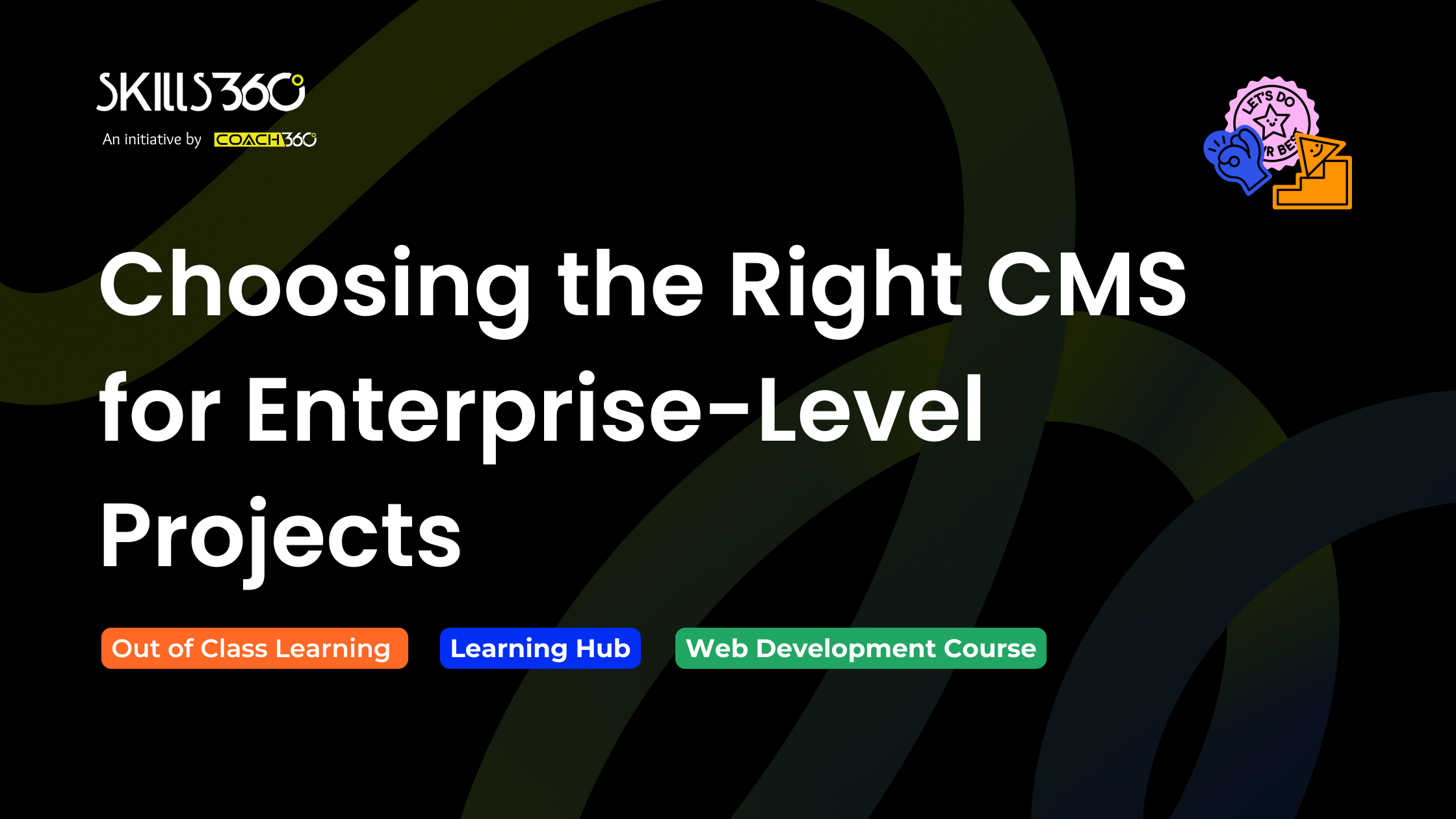- Featured article
- People at Skills360 10 - Nov 2025 | 12 min read

Today, for modern businesses, a website is no longer just a digital brochure. A website is now a dynamic, data-driven platform that integrates systems, delivers content, and enables seamless experiences for users. When a business grows, it can be difficult to manage all of the content, the various departments responding to those requests, and multiple digital touchpoints. This is where a Content Management System (CMS) comes in.
But, not all CMSs are made for enterprise businesses. The needs of a global enterprise company, the ability to manage multi-sites, security compliance, and deep integration options - are far greater than a smaller CMS could support. When it comes to enterprises needing to choose a CMS for a project, that is a strategic decision related to your digital future, not only a technical decision.
At Skills360, we help learners and professionals understand the difference between a standard CMS and an enterprise grade CMS through our various web technologies courses, including our enterprise CMS development course in Karachi. Let's consider the key aspects of making the right choice.
An enterprise content management system should not focus solely on content editing. This platform should provide the scalability, flexibility and governance necessary for large-scale, enterprise-level businesses.
The requirements for a CMS platform capable of accommodating an enterprise often encompass a level of complexity and size that CMSs intended for smaller, simpler sites and blogs do not. It needs to be able to expect hundreds of contributors to content, graphics, etc., across multiple languages and with varying data flows, and still maintain performance.
For enterprise organizations, CMS platforms often are the central digital hub in the enterprise ecosystem that ties into customer relationship management platforms (CRMs), marketing automation, ERP software, etc. Using the wrong CMS can lead to a fragmented workflow, poor collaboration, and expensive reworks.
The correct CMS system will provide not only effective methods for managing content, but also architecture ready for other technologies, such as artificial intelligence, automation, and headless frameworks.
As your organization expands, your CMS needs to be able to handle larger volumes of content, spikes in traffic, and various publishing needs on different platforms, without increasing IT costs. Cloud-based solutions such as Adobe Experience Manager (AEM), Sitecore, and Contentful are built to scale easily, and maintain performance, even during heavy traffic.
A scalable CMS will also enable modular growth, such as adding additional websites, microsites or geolocations, without needing to start over. This allows enterprises to grow globally, while providing consistent digital branding.
Because enterprise websites often deal with sensitive user data, security is a top concern. The CMS should include advanced role-based permissions, encryption, audit trails, and compliance support (GDPR or HIPAA).
You will find that open-source CMS options, like Drupal, offer strong security modules and a large community of active users who regularly apply patches to address any security incidents. Enterprise-focused commercial solutions also provide some level of built-in compliance and offer managed hosting, which minimizes security risks to a certain extent.
Lastly, before making a final decision, make sure to review the CMS's incident history, especially how they've acted on vulnerabilities.
Standalone systems are seldom utilized by enterprises. Your CMS must integrate seamlessly with tools like Salesforce (CRM), HubSpot (marketing automation), or SAP (ERP) to deliver unified digital experiences.
Modern CMS solutions, especially headless and API-first systems, help in this regard. For example, Strapi and Contentful make integration easier through a backend that is decoupled from the frontend tech solution. The resulting flexibility allows developers to build experiences across web, mobile, and IoT, while managing the content in one place.
If you’re learning through a structured training path like the enterprise CMS development course in Karachi, API integration may be one of the most useful skills for your future projects.
Big teams require structured workflows to guarantee consistency and quality, so enterprise CMS platforms (or similar applications) should provide support for customised publishing workflows, user roles, and approval chains.
Sitecore is an optimal option for editors, approvers and administration to work both efficiently and collaboratively, and WordPress can accomplish similar editorial controls with enterprise-added plugins like Edit Flow or PublishPress.
Establishing governance is a safeguard against version conflicts while safeguarding brand consistency in separate geographies and/or product lines; this is critical if you are a multi-national organisation.
Organizations that operate on an international scale usually are expected to manage more than one website by region or country and content in multiple languages. A solid CMS should provide multi-domain architecture, internationalization and autotranslation, and local SEO considerations with no impact on experience or performance.
Solutions such as Drupal and Kentico Xperience have no problem addressing this, along with several translation management and localization tools available off-the-shelf. It is ideal to accommodate a unified experience for the organization's regional markets while having access to local market teams to help leverage local knowledge for there translated content.
Even though enterprise CMS platforms have come a long way in terms of sophistication, these platforms also need to be easy to use. Editors and marketers should not have to be coders to be able to create, edit, or publish content.
An adequate CMS will provide a clean User Interface, an easy drag-and-drop process, and the ability to create customised dashboards! The CMS itself can be extended or new features integrated, via developer APIs or modules, all the while the current workflows are not interrupted.
The effectiveness of training teams to efficiently use these features will pay dividends for long-term ROI. This is what structured programs like the enterprise CMS development course in Karachi aim to do.
Lastly, think about the total cost of ownership, which includes licensing fees, hosting, maintenance, and scalability costs.
Open-source platforms such as WordPress and Drupal have lower upfront costs but may require greater technical management skills than a proprietary solution. Proprietary solutions such as AEM or Sitecore may have license fees but also provide support, hosting, and out-of-the-box features that are not always available in open-source.
It is important to strike a balance between the need for long-term flexibility and restricted funding for agencies managing more than one client’s sites and government institutions requiring a compliance guarantee.
In recent years, organizations have begun to adopt more headless-based CMS structures - where the content management (back-end) is separated from the presentation (front-end). This provides greater flexibility for content delivery through various channels such as websites, apps, smart devices, and digital kiosks.
Composable CMS systems expand the flexibility of a headless CMS, allowing teams to seamlessly combine best-of-breed tools - content delivery, analytics, eCommerce, and automation, through APIs. This model is the future of scalable and flexible content management for both developers and marketers.
At Skills360, we are excited for students to explore these technologies through hands-on training in modern CMS ecosystems. The enterprise CMS development course in Karachi is designed to provide students with experience in headless architecture, API integration, and performance optimisation - skills which are becoming increasingly important to global tech employers.
In recent years, organizations have begun to adopt more headless-based CMS structures - where the content management (back-end) is separated from the presentation (front-end). This provides greater flexibility for content delivery through various channels such as websites, apps, smart devices, and digital kiosks.
Composable CMS systems expand the flexibility of a headless CMS, allowing teams to seamlessly combine best-of-breed tools - content delivery, analytics, eCommerce, and automation, through APIs. This model is the future of scalable and flexible content management for both developers and marketers.
At Skills360, we are excited for students to explore these technologies through hands-on training in modern CMS ecosystems. The enterprise CMS development course in Karachi is designed to provide students with experience in headless architecture, API integration, and performance optimisation - skills which are becoming increasingly important to global tech employers.


Get curated emails on out of class learning and work on your skills on your free time.